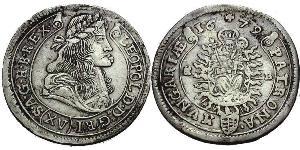(sold for $164.0)
1621, Frankfurt (Free City), Ferdinand II. Large Silver Thaler Coin. Cleaned VF+
Mint Year: 1621 Denomination: Thaler Mint Place: Frankfurt am Main Mint Official: Caspar Ayrer (Æ) Reference: Davenport 5289, KM-72.1. R! Condition: Cleaned/brushed, margina weight-adjusting marks, otherwise VF+ Weight: 28.70gm Diameter: 43mm Material: Silver
Obverse: Heraldic eagle of Frankfurt within foliage on large cross within inner circle. Legend: * . MONETA . NOVA : REIP : FRANCOFVRTENSIS : I6ZI Reverse: Crown above double-headed nimbate imperial eagle with cross-topped orb at chest. Legend: (privy mark: key) FERDINAND . II . D : G . ROM . IMP . SEMP . AVGVST . (AE) .
Frankfurt was one of the most important cities in the following Holy Roman Empire. From 855 the German kings and emperors were elected in Frankfurt and crowned in Aachen. From 1562 the kings/emperors were also crowned in Frankfurt, Maximilian II being the first. This tradition ended in 1792, when Franz II was elected. His coronation was deliberately held on Bastille Day, 14 July, the anniversary of the storming of the Bastille. The elections and coronations took place in St. Bartholomäus cathedral, known as the Kaiserdom (en: Emperor's Cathedral), or in its predecessors. The Frankfurter Messe (Frankfurt Trade Fair) was first mentioned in 1150. In 1240, Emperor Friedrich II granted an Imperial privilege to its visitors, meaning they would be protected by the Empire. The fair became particularly important when similar fairs in French Beaucaire lost attraction around 1380. Book trade fairs have been held in Frankfurt since 1478. In 1372 Frankfurt became a Reichsstadt (en:Imperial city), i.e. directly subordinate to the Holy Roman Emperor and not to a regional ruler or a local nobleman. Frankfurt managed to remain neutral during the Thirty Years' War, but suffered from the bubonic plague that was brought to the city by refugees. After the end of the war, Frankfurt regained its wealth.
em>.
Ferdinand II, Holy Roman Emperor (July 9, 1578 – February 15, 1637), of the House of Habsburg, reigned as Ferdinand II, Archduke of Inner Austria (normally called Ferdinand II of Germany when referred to as Archduke) and Holy Roman Emperor from 1619-1637. He was also the Archduke of Styria (Inner Austria) from 1590–1637, King of Bohemia from 1617-1619 and again from 1620-1637, as well as King of Hungary and Croatia from 1618-1625. The expansion of the ongoing acts of rebellion against his Imperial Governors in Bohemia on May 23rd, 1618 directly triggered the Thirty Years' War, and can be blamed on his religious intolerance toward Protestants.
A devout and very pious Catholic, his recognition as King of Bohemia and suppression of Protestantism precipitated the early events of the Thirty Years' War, and he remained one of the staunchest backers of the Anti-Protestant Counter Reformation efforts as one of the heads of the German Catholic League, prolonging the Thirty Years' Wars by insisting the Edict of Restitution be enforced. The duration of his reign was occupied by confessional and military concerns, and some historians blame him for the large civilian loss of life in the Sack of Magdeburg in 1631, as he'd instructed Count Tilly to enforce the edict upon Saxony—his orders causing Tilly to move the Catholic armies east, ultimately to Leipzig, where they suffered their first substantial defeat at First Breitenfeld.
(July 9, 1578 – February 15, 1637), of the House of Habsburg, reigned as Ferdinand II, Archduke of Inner Austria (normally called Ferdinand II of Germany when referred to as Archduke) and Holy Roman Emperor from 1619-1637. He was also the Archduke of Styria (Inner Austria) from 1590–1637, King of Bohemia from 1617-1619 and again from 1620-1637, as well as King of Hungary and Croatia from 1618-1625. The expansion of the ongoing acts of rebellion against his Imperial Governors in Bohemia on May 23rd, 1618 directly triggered the Thirty Years' War, and can be blamed on his religious intolerance toward Protestants.
A devout and very pious Catholic, his recognition as King of Bohemia and suppression of Protestantism precipitated the early events of the Thirty Years' War, and he remained one of the staunchest backers of the Anti-Protestant Counter Reformation efforts as one of the heads of the German Catholic League, prolonging the Thirty Years' Wars by insisting the Edict of Restitution be enforced. The duration of his reign was occupied by confessional and military concerns, and some historians blame him for the large civilian loss of life in the Sack of Magdeburg in 1631, as he'd instructed Count Tilly to enforce the edict upon Saxony—his orders causing Tilly to move the Catholic armies east, ultimately to Leipzig, where they suffered their first substantial defeat at First Breitenfeld.

|
Posted by:
anonymous 2018-05-18 |
2 Florin / 2 Gulden Austria-Hungary (1867-1918) Silver Franz ...
group has 20 coins / 18 prices
⇑
















-300-150-KgQKX9ISLlMAAAFYVIy668M0.jpg)






